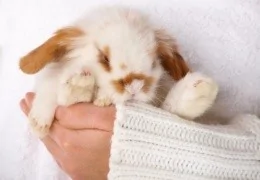The Tornjak originated from genetically homogeneous, almost extinct, indigenous shepherd dogs. These dogs have...
THE ALASKA RABBIT
INTRODUCTION
The Alaskan rabbit was the brainchild of Max Gotha, a German rabbit judge, and another German rabbit breeder. The goal was to create a rabbit resembling the Alaskan fox for the fur trade and, to that end, their breeding programme began in 1900.
THE ORIGIN OF THE ALASKA RABBIT
The Alaskan rabbit was the brainchild of Max Gotha, a German rabbit judge, and another German rabbit breeder. The goal was to create a rabbit resembling the Alaskan fox for the fur trade and, to that end, their breeding programme began in 1900.
The initial plan for the new breed was to breed a silver-black rabbit, a black animal with very long white guard hairs. For unknown reasons, breeders eventually settled on the Alaskan as it is known today, an intensely black rabbit with long, shiny, night-black guard hairs and no silvering.
The breed was first exhibited in 1907 in Europe and, decades later, came to the United States via Holland and Canada. The American Rabbit Breeders Association (ARBA) recognised the breed in the mid-1970s. However, the recognition was short-lived. In 1980, ARBA recognised Havana black rabbits, which was a death knell for Alaskan rabbits, at least in the USA.
Apparently, interest in the Alaskan rabbit declined drastically, as in 1981 it was eliminated from the ARBA. We do not know if Alaskan rabbits are still kept in the USA.
WHAT DOES THE ALASKAN RABBIT LOOK LIKE?
[Incomplete in the official books]
1. TYPE, SHAPE AND CONSTRUCTION OF BODY: The body is robust (blocky). The chest and back are broad, the back line is even and well rounded at the rear.
The medium length legs are strong. The doe is a little thinner. A small, well formed dewlap is permitted in older bitches.
2. WEIGHT:
- NORMAL WEIGHT: 3.25 kg.
- MINIMUM WEIGHT: 2.50 kg.
- MAXIMUM WEIGHT: 4.00 kg.
3. COAT HAIR: Dense and finely and evenly wiry. The ears are well covered with hair.
THE HEALTH OF THE ALASKA RABBIT
All rabbits should be vaccinated against myxomatosis and rabbit faeces disease, two potentially fatal diseases which can be transmitted by infected animals, bedding, utensils or toys. They should also be regularly treated for fleas, ticks and worms.
Dental hygiene is an essential part of rabbit care. As a rodent, their teeth are continually growing and will need a proper diet to keep them worn down. Overgrown teeth can cause many problems for your pet, including difficulty eating and mouth lesions that can lead to abscesses. The best way to combat tooth overgrowth and enamel spurs is to prevent them from occurring in the first place by providing a diet rich in good quality hay and plenty of fibrous green vegetables, such as cabbage and kale. Chew toys also help to keep teeth under control. If you suspect a dental problem, your vet can perform an examination and any necessary corrective work.
Your rabbit should never be allowed to become overweight. Excess weight will prevent your pet from grooming itself properly and, if it cannot groom itself, flies may be attracted to dirty areas of the coat. These flies may lay their eggs in the fur and the larvae that hatch will bury themselves in your rabbit's skin, causing severe discomfort and even infection. Myiasis can be prevented by keeping your rabbit's weight down and making sure his coat and bedding are scrupulously clean.
THE PERSONALITY OF THE ALASKAN RABBIT
Although not very popular, Alaskan rabbits make excellent pets and will be a welcome addition to your family. Alaskan rabbits are docile and will not scratch, bite or frighten in any way if handled properly. They are also one of the most intelligent breeds and are on par with intelligent dogs and cats. With patience and practice, Alaskan rabbits can be trained to do little tricks, easily discover their litter box and come to you when you call their name. Alaskan rabbits make excellent pets.
CONCLUSION
With an interesting history that included attempts to produce all-white fur, the almost jet black Alaskan rabbit was saved from becoming a fur coat. However, that was great news for anyone wanting a fantastic family pet. Alaskan rabbits are relaxed, affectionate and truly beautiful rabbits. They live a long time, like to cuddle, are easy to handle and can be easily trained.
Leave a comment
Log in to post comments
















